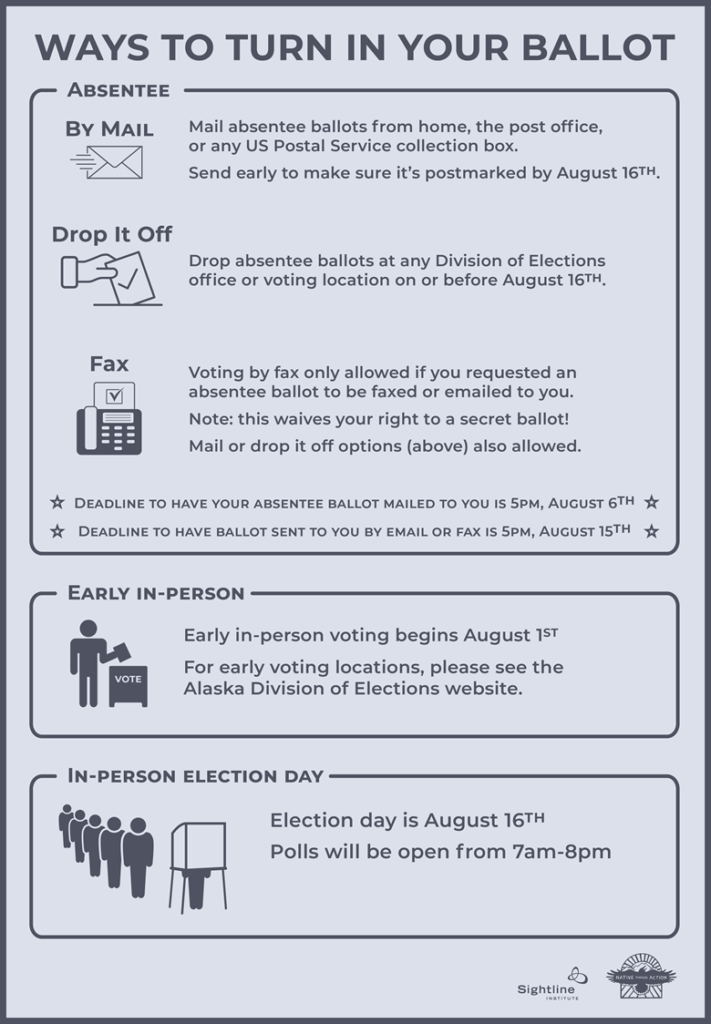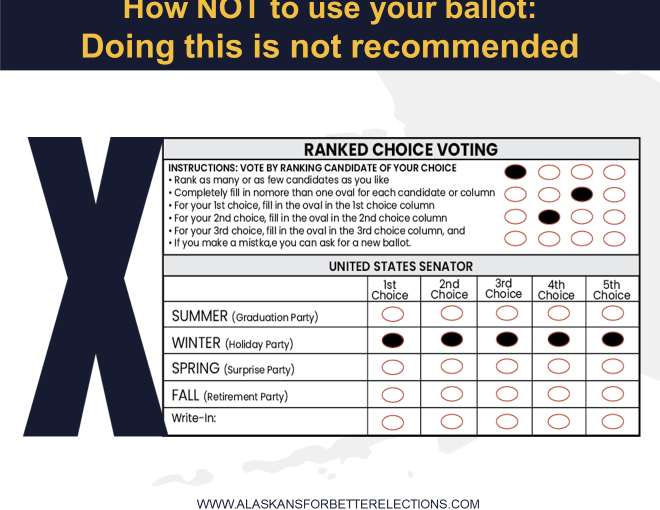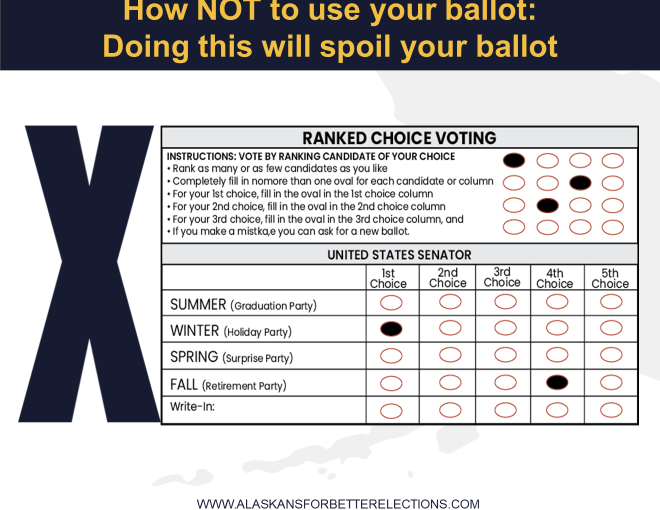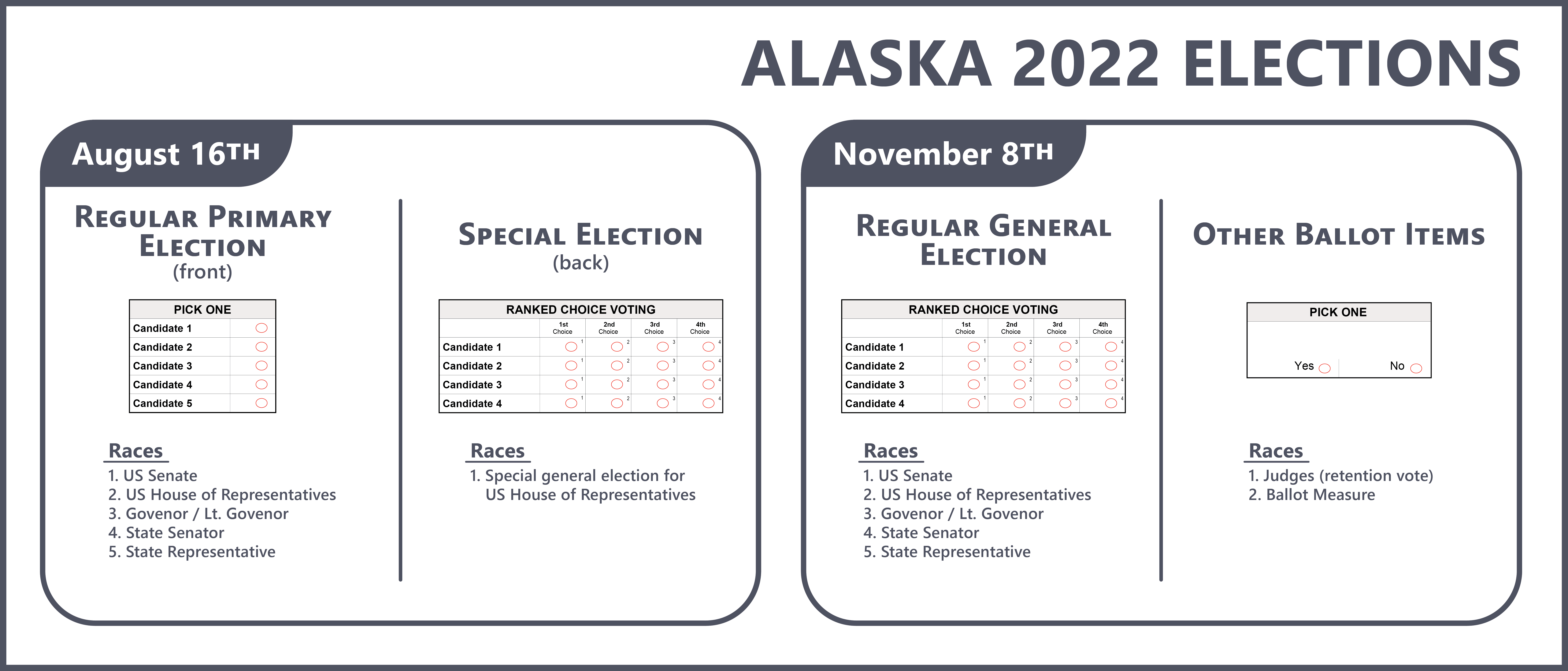Find audio versions of Sightline articles on any of your favorite podcast platforms, including Spotify, Google, and Apple.
Author’s note: I’ll be updating this article regularly with new information and additional questions we hear from readers. As noted below, I invite questions in the comments section, by email, and on Twitter.
August is a big month for Alaska voters, with a regular midterm primary election and special general election happening on the same day. The races will appear on the same ballot.
Our best advice? Don’t forget to flip it over and complete both sides! The front of the ballot features pick-one primaries for governor and other statewide races. Flip it over to vote in Alaska’s first ever ranked choice election. The winner of the ranked choice election will temporarily fill the US House seat held most recently by the late Representative Don Young.
2022 marks the first year Alaska voters will use a combination of pick-one open primaries and ranked choice general elections to choose their lawmakers. When combined, the two voting reforms promise to help tamp down extreme partisanship, encourage cooperation between candidates, and let voters opt for their true favorites rather than candidates they merely tolerate.
Below we answer the top questions we’ve been hearing about Alaska’s August 16, 2022, primary and special general elections.
- General info on Alaska’s August 2022 elections
- Info about the candidates on the August 2022 ballot
- Who are the candidates running in the primaries and special general election?
- How do I learn more about the candidates and the issues?
- What do the political party labels next to each candidate’s name actually mean?
- How can I find out which candidates each political party has endorsed?
- If four or fewer candidates appear in a race, do they all advance to the general election?
- Only three candidates are competing in the special general election. Why is that?
- How long will the winner of the special election serve in office?
- How to cast a ballot in Alaska’s August 2022 elections
- What are my voting options?
- Where do I get an absentee ballot for the August 2022 elections?
- How should I turn in my absentee ballot?
- If I vote absentee, can I track my ballot?
- How can I get election materials in Alaska Native languages, Spanish, Tagalog, and other languages?
- How do I fill out my ballot correctly?
- Do I have to rank all of the candidates?
- What are some common mistakes to avoid when ranking candidates?
- How do I replace a lost ballot?
Sightline Institute is also producing and sharing free voter education resources for Alaska at sightline.org/AlaskaVote, including graphics detailing key election dates, sample ballots, and a map of regional election offices. If you still have questions after reviewing the ones below, please don’t hesitate to email me or ask me on Twitter. I’ll update this article with additional information you ask for.
General information on Alaska’s August 2022 elections
The regular midterm pick-one primary and the special ranked choice general election are both on the ballot due August 16.
Voters in the primary will pick one candidate per race. The top four vote-getters in each race will move on to the general election. The primaries will include races for governor, US Senate, US House, and both houses of the Alaska state legislature.
The special general election will fill the seat of Representative Don Young, but just for a short time. The longtime Congressman died in March at the age of 88. Voters need to choose a new representative to serve out the last several months of his term in the US House.
Including both elections on a single ballot allows the Alaska Division of Elections to be more efficient in a year with an unexpected special election.

What’s a pick-one primary?
In a pick-one open primary, all candidates appear in a single race, regardless of party affiliation. Voters pick their one favorite. The top four vote-getters in Alaska’s primary advance to the ranked choice general election in November. Voters will use the pick-one primary in August in races for legislature, governor, US Senate, and the full two-year term for US House.
Alaskans already voted in a pick-one primary earlier this year. The special primary election for the late Don Young’s US House seat, held in June, sent four candidates to the special general election: Sarah Palin, Nick Begich, Al Gross, and Mary Peltola. (Gross later dropped out, leaving only three candidates in the running.) The special general election featuring Peltola, Begich, and Palin will appear on the back side of the August ballot, where voters will use ranked choice voting to indicate their preferences among the three.
How will ranked choice voting work in the special general election?
The ranked choice election for Congressman Young’s seat appears on the back of the August ballot. Voters will rank those candidates in their order of preference. (This quick video shows how election officials count ranked choice ballots and determine a winner.)
Once the polls are closed, everybody’s first-choice vote is counted. If a candidate receives a majority of the first-choice votes (50 percent plus 1), that candidate is the winner. If no candidate achieves a majority with first-choice votes alone, then the candidate with the fewest first-choice votes is eliminated. The voters who preferred that candidate will then have their vote count for their next preference on their ballot. The elimination of candidates and redistribution of votes continues until a candidate receives a majority of the vote.
How do I keep track of key election dates?
The special general election and the regular primary election both take place on Tuesday, August 16. This is the last day to postmark a vote by mail ballot or cast a ballot at a Division of Elections Regional Office.
We made a free timeline of all of Alaska’s key 2022 election dates. It’s printable and social media-shareable. You could use it in a PowerPoint, or turn it into a fridge magnet, flyer, or poster.

How do I register to vote in the August 2022 primary and special elections?
If you are an eligible voter in Alaska and applied for a Permanent Fund Dividend in 2021, you were automatically registered to vote. To check your voter registration status, go to the state’s My Voter Information page.
If you need to register or change your voter information, visit the state’s Online Voter Registration page. The deadline to register for the August midterm primaries and special general election is Sunday, July 17.
Info about the candidates on the August 2022 ballot
Who are the candidates running in the primaries and special general election?
The Division of Elections has candidate lists on its website.
How do I learn more about the candidates and the issues?
The Anchorage Daily News (ADN) is gearing up to grill candidates by asking readers what questions they’d like to have answered.
Voters can watch the candidate forum in June featuring the special general election candidates for US House. The three candidates told Alaska Public Media where they stand on the legitimacy of the 2020 presidential election. And before the special primary, the ADN surveyed House candidates on a host of issues.
What do the political party labels next to each candidate’s name actually mean?
Each candidate’s chosen political party (e.g., Democrat, Republican, Libertarian) appears in parentheses next to their name on the ballot. This means the candidate is registered with the party but does not mean the party has endorsed them.
In some cases, the candidate will have chosen not to affiliate with a party at all.
How can I find out which candidates each political party has endorsed?
The Alaska Democrats list the candidates they’ve endorsed so far on their website.
The Alaska Republicans have so far endorsed Nick Begich for US House; Governor Mike Dunleavy and Kenai Borough Mayor Charlie Pierce for governor; and Kelly Tshibaka for US Senate.
The Alaska Libertarian Party has so far endorsed Chris Bye for US House.
If four or fewer candidates appear in a race, do they all advance to the general election?
Yes.
The top of the ticket features fairly large candidate lists. The US Senate race has 19 candidates. The US House race has 22. The gubernatorial race has 10 governor/lieutenant governor pairings. In these races, the pick-one primary will send the top four vote-getters in each race on to the general election, where voters will have the chance to rank them.
The state legislature is a different story. Only one legislative race features more than four candidates in the primaries. (The House race for District 35 has five candidates.)
Only three candidates are competing in the special general election. Why is that?
The special primary election occurred on June 11, 2022. Four candidates advanced out of a field of 48 candidates: Sarah Palin, Nick Begich, Al Gross, and Mary Peltola. Gross later dropped out, leaving only three candidates in the running. Alaska election law barred the fifth-place candidate, Tara Sweeney, from replacing Gross.
How long will the winner of the special election serve in office?
The winner of the special election will serve from September 2022 through January 2023, when Young’s two-year term was scheduled to end.
The winner of the regular midterm election will assume Alaska’s House seat in January 2023. They could be the same person who won the special election if that individual also runs in the regular election, or they could be someone else.
How to cast a ballot in the August 16 election
What are my voting options?
Voters can vote:
- early in person, or
- absentee, or
- in person on Election Day.

For early voting and Election Day voting locations, please see the Alaska Division of Elections website at www.elections.alaska.gov.
Where do I get an absentee ballot for the August 2022 elections?
Voters must request an absentee ballot from the Division of Elections using an online or paper form. To have your absentee ballot mailed to you, you must request it by August 6. To have your absentee ballot sent to you by email or fax, you must request it by August 15. Find more information on absentee voting at the Division of Elections website.
How should I turn in my absentee ballot?
By Mail: Mail your absentee ballot from home, the post office, or any US Postal Service collection box. Do it early to make sure it’s postmarked by August 16.
Drop It Off: Drop your absentee ballot at any Division of Elections office or voting location on or before August 16.
Fax It: If you requested an absentee ballot to be faxed or emailed to you, you can vote by fax but are waiving your right to a secret ballot. (You can also use the by-mail or drop-it-off options, noted above.)
If I vote absentee, can I track my ballot?
Sign up for ballot tracking to follow your absentee ballot through the voting process. You’ll get updates by text and/or email. It’s a lot like tracking an item you’ve ordered online.
How can I get election materials in Alaska Native languages, Spanish, Tagalog, and other languages?
In Alaska, voters can obtain election materials and help from translators either in person or by phone in a variety of languages. The Division of Elections is communicating with voters statewide in Alaska Native languages, Spanish, Tagalog, and other languages required for Alaska by federal law. Posters, brochures, radio spots, and other translated voter information will be available as the year goes on, according to the division’s language compliance manager Samantha Mack.
In writing
Voter registration applications: Available in Tagalog, Spanish, six Yup’ik languages (General Central Yup’ik, Norton Sound Kotlik Yup’ik, Yukon Yup’ik, Hooper Bay Yup’ik, Bristol Bay Yup’ik, Chevak Cup’ik) and Nunivak Cup’ig. Gwich’in will be available soon as well.
Absentee ballot applications: Available in Tagalog, Spanish, and six Yup’ik languages. Nunivak Cup’ig and Gwich’in will be available soon as well.
Sample ballots: Available in Tagalog, six Yup’ik languages (see above), Nunivak Cup’ig, Gwich’in, Inupiaq (Northern), and Unangam Tunuu.
Real ballots: The actual ballots will all be in English. In precincts with electronic voting tablets, translated audio is typically available in Spanish, Tagalog, six Yup’ik languages (see above), Nunivak Cup’ig, Gwich’in, and Inupiaq. Voters are allowed to use sample ballots as an aid.
Official election pamphlets: Available in Tagalog and Alaska Native languages. For the first time, the division will mail the Alaska Native language versions of the pamphlets direct to voter households this year, in addition to the usual household mailings of the Tagalog version. The division for the first time will also allow voters to bring the pamphlets to polling places. Digital versions of the pamphlet in Spanish will be available on the division’s website.
Election glossaries: The division is issuing updated elections glossaries for all Yup’ik languages as well as Gwich’in. The update includes terms and phrases related to ranked choice voting and the new top four primary system. These glossaries are complete and will be available on the Division’s website. An Unangam Tunuu elections glossary is in the works.
Nonpartisan top four primary and ranked choice voting FAQ: Available online in six Yup’ik languages, Spanish, Tagalog, Nunivak Cup’ig and Gwich’in.
PowerPoint presentation: The division is translating a printable PowerPoint presentation about the new election system into all languages typically provided by the division.
In person
On election days (primary and general), on-call interpreters and bilingual registrars, outreach workers, and poll workers will be available in certain communities based on the availability of poll and outreach workers.1
Voters may have a person of their choice provide assistance as long as that person is not a candidate, their employer, an agent of their employer, or an agent of their union. The voter’s assistant may go into the voting booth to help the voter cast their ballot.
By phone
Voters may call a toll-free language assistance number on or before Election Day: (866) 954-8683 or (907) 275-2333.
Radio
Public service announcements are airing in Tagalog, Spanish, six Yup’ik languages, and Gwich’in, and the division is working on more in Inupiaq and Unangam Tunuu. The PSAs cover registration deadlines, candidate deadlines, list maintenance, accessibility assistance, availability of the Official Election Pamphlet, the dates of elections, and when voting will occur. PSA audio and written text will also be available on each language’s respective webpage.
By mail
The division is sending translated mailers direct to voter households and to tribal councils2
Videos
The division has translated educational videos about the new election system on its website and YouTube. The division plans to share the videos on social media in conjunction with Alaska Native regional corporations and other community organizations, including Get Out the Native Vote.
Mock elections
Alaska’s mock election educational tool, including detailed results and explainers, is available in more than two dozen languages, including several Alaska Native dialects.
How do I fill out my ballot correctly?
In the primary election, all candidates appear in a list on the ballot. Pick one. The top four voter-getters will then advance to the general election ballot, where voters can rank them from most to least favorite.
In the special general election, voters have the opportunity to rank the candidates. The first-place vote goes to a voter’s favorite candidate, and so on.
Do I have to rank all of the candidates?
No. That being said, in the special election, you should try to rank at least two. If you choose only one candidate and do not rank anyone second, you will be throwing away the chance to weigh in on the rest of the field. Other voters will be making a choice without you.
What are some common mistakes to avoid when ranking candidates?
Filling out your ranked choice ballot the wrong way means you risk spoiling your special general election ballot. Either your vote won’t count, or you’ll end up effectively voting for just one candidate, rather than having your vote redistributed to your next-favorite candidate(s).
Do not rank a candidate more than once. Your vote will not count for that candidate more than once.

Do not give the same ranking to more than one candidate.

Do not skip rankings.

Replacing a lost ballot
Lost your ballot? Contact any Division of Elections office to request a replacement ballot for the special primary election. You can request a new ballot be delivered electronically by August 15 at 5 p.m.
What’s next?
Go vote!


